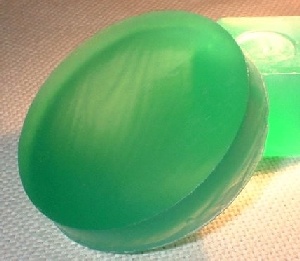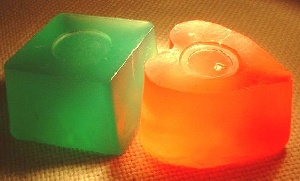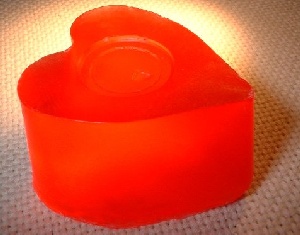


Glycerine Soaps and
|
Glycerine soaps in general are soaps, which are more or less transparent. Apart from this special appearance glycerine soaps can be easily melted and shaped. Because of the high alcohol content they are better in maintaining the scents and they also do not tend to change the aroma tone. Transparency is based on the same chemical-physical effect which also makes glass transparent, because glycerine soaps are actually soaps remaining in the molten state. They are ‘frozen’ solutions, whose molecules are not yet in a crystalline order.
Transparent soaps require very pure basic ingredients. There are fats and oils, which give more transparency than others. Animal fats (suet,’Unschlitt’, lard) and rizinus oil have the best properties concerning transparency. Soap produced from them will be brought into a state of solution by addition of various types of alcohol such as glycerine, ethyl alcohol, isopropyl alcohol, sorbitol or glycol. Soap boilers often are pleased to see a solution almost as clear as water. Disappointment follows after the solution has cooled down. The soap solidifies but looses transparency. Long, thread-like soap molecules are formed, which are intermeshed. The challenge in producing transparent soaps is the stabilization of the actual state of the melt. This is usually helped by addition of a sugar solution.
Industrially made glycerine soaps often have an excellent transparency, which an amateur could hardly achieve. Processing secrets may be involved and additives such as tetrasodium EDTA or sodium etidronate, which are usually avoided by amateurs. It remains an ambitious goal to produce soap as pure and transparent as possible by amateur means.
MP-soaps are industrially or manually produced glycerine soaps, which can be melted as often as possible and poured into moulds. MP-soaps often are the ‘entry-drugs’ for soap-makers. The process of melting soap in water or in a microwave-oven is so simple that many enthusiastically begin with boiling of soaps. The retail market offers many ‘sets’ and ‘kits’, which contain the basic materials – mostly some pieces of highly transparent colorless and non-perfumed glycerine soap, pigments, perfumes and hollow moulds. Handling MP-soaps is relatively safe, and even children can deal with it. Fun to work with in many kindergartens and schools.
Representative for a series of suppliers is a website for MP-soaps in Germany
http://www.seifenkuenstler.de/
where one can buy anything useful required for this hobby.
In the meantime one can find hobby-sets in all better-equipped hobby-stores.They can even be found in the hobby-section of do-it-yourself-stores.
Transparent glycerine soaps have been known since about 200 years. A famous example is "Pears’ Soap" by Andrew Pears, who in 1789 opened a barbershop in a noble part of London and soon started to make his own pomades, crèmes and soaps. Always a touch of luxury has been connected to transparent soaps, because they were made from high quality raw- materials and accordingly were expensive. Their recipes often were passed on incompletely. "Mystical" additives concealed the real purpose of the additives. In general the manufacturing process of transparent glycerine soaps is more important than the recipe.
It is no surprise that the secret and beauty behind glycerine soaps are considered a challenge for experimentation among hobby soap boilers. To study a good manual is often a good beginning. Not all authors care to pass on openly their experience. Good books about transparent soaps are rare.
Among hobby soap boilers an acknowledged reference is the book
Catherine Failore: "Making transparent soap".
It describes her favoured process very accurately and so precisely that a subsequent boiling will succeed. The author has also learned a lot from Catherine. Accordingly most facts mentioned here are to a great extent based on Catherine Failor’s experiences.
The process consists of the following main parts:
This makes a total of about 400g fat. Following the standard saponification tables one has to admix to this amount of fat 60g NaOH, dissolved in 125g distilled water at a common temperature of about 60°C (140°F). This is less water than usual, because quite a bit of extra fluid is being added.
As before a bar-mixer is used for mixing and stirring until the mass has thickened. The rule is: the higher the temperature and the more intensive the stirring the faster the whole process. One should, however, not work at too low a temperature (although this is all called a ‘cold process’). Preferably this saponification process should occur in a pot with a water wall or in a pot within a pot in a water bath. Goal is total saponification. The mass thus should remain in the pot until the formation of gel. It is a good idea to regulate the temperature by external heat transfer. Self-heating with such a small amount of fat is not very large, especially during winter and in a cold kitchen. The mass should then saponify at about 77°C to 81°C (170 - 178°F).
The one who can afford a simmering pot has found the ideal pot for saponification. Simmering pots were invented to boil milk. One can heat milk in a water bath without scorching it. Water vapour escaping the pot causes a small whistle to blow or metal tongs to resonate like in a mouth organ.
If so desired one can now start to color the soap. One should use water-soluble paints. Fat pigments will scatter the light at the expense of the soap’s transparency. The soap should ‘simmer’ for about one hour and thereby pass into the gel phase or into the colloidal state. It is best to cover the soap pot with a plastic foil. Strong rubber rings as used in jam glasses prevent slippage of the foil. One can thus observe the progress of the process without disturbing it. Afterwards stir the gel and stir under the cold rests from the surface and from the edge of the pot. This assures a homogeneous ageing of the soap. The pot will be covered again and kept at temperature for another hour. The objective is the complete saponification of all fats and oils.
One can determine this state by measuring the pH-value. The simplest way is to use the phenolphtalein indicator. One adds a few droplets of soap mass onto a white soap dish (it can also be a white plastic dish) and then adds a few droplets of phenolphthalein/alcohol solution. The indicator should turn light-pink to light. If it turns red, almost purple, then the soap hasn’t aged enough yet. Either one has made a mistake in weighing or the mass has not been sufficiently stirred or boiled.
In the mean-time one has to prepare an alcohol-glycerine solution. Compared with the weighed amount of fat/oil one should get 150g alcohol (90% to 96% sprit, also called ethanol or ethyl alcohol) and 100g glycerine from the pharmacy. Spirit would be noticed in the soap as unpleasant.
Dealing with pure alcohol is not without problems, if one simultaneously has to work over open fire, e.g. a gas stove. Alcohol fumes are ignite easily. An electric stove is already a bit safer. If one does not have a fire extinguisher in the soap kitchen, one can use a water spray-bottle , as available for wetting indoor plants , as a suitable extinguisher.
Alcohol and glycerine are then carefully heated together to a temperature of about 60°C (140°F). Alcohol already starts to boil at 80°C (186°F). Be careful, the fumes can ignite, apart from the fact that a drunken soap boiler will become unreliable.
The warm mixture of alcohol and glycerine is the solvent for the gel-like soap. The mixture will be drained from the pot while continuously stirring. Initially the soap will still lump, but then it will completely dissolve and form a clear liquid. Solid edges of soap along the walls of the pot should be scraped off and stirred into the mass. A birch or a bar-mixer is the best-suited tool to stir with.
Now the pot will be covered with a transparent plastic foil and rubber rings. The pot should now only be further heated in the water bath. If there just was a simmering pot! The water should be kept lightly boiling for 30 minutes. After that everything should have gone into solution.
During boiling a sugar solution needs to be prepared. One dissolves
The solution will be brought to a gentle boil until the sugar has been completely dissolved and runs off from the spoon in a thin jet .
Consider the total amount of this recipe:
will together amount to 1000g soap. The ‘yield’ is thus 1000/400 = 2.5
This consideration is important for establishing the price. Rizinus oil, alcohol and glycerine are expensive. In total glycerine soaps will always be more expensive than cold-stirred soaps.
The pot will now be removed from the fire, and the sugar solution stirred into the dissolved soap. Afterwards it is advisable to leave the mass sitting for another 20 min. The pot will be covered again and allowed to cool down to about 60°C (140°F).
The somewhat cooler mass can perhaps still be covered by some foam.It should be siphoned off in order to get a clear and glossy surface. Now the time has come to add aroma. The high alcohol content acts as a good carrier for aroma. Aroma can be easily added to glycerine soaps, because the soap hardly has any odor left and it won’t change the aroma.
The slightly cooler and still liquid soap can now easily be poured into a mould..It can be poured into a box-shaped mould or into singular moulds, which can also have fine surface details., because the liquid will fill all corners and angles of the mould. In order to keep the surface glossy and without bubbles, one can spray the moulded pieces with a bit of alcohol using a spray-can.
The cooled mass should be easily removed from the mould. The mould should have a glossy surface, because the soap will reproduce every detail of the surface structure. It is not recommended to use a mould release agent agent such as vaseline. It would attack the surface of the soap and deteriorate the appearance.
The molded soap should lie for another 2 weeks, not to ‘further age’, which often is so important with cold-stirred soaps, but to dry a bit more. Soap boilers report that the transparency can even increase after this ageing time.
As with any glycerine soap the waste can be remelted, best with the next amount of the same color. The waste is too valuable to be thrown away.
The success rate of this recipe, which is broadly based on the book of Catherine Failore, should be high. Nevertheless, more experimentation should be fun. For example one can vary the alcohol mixture. Ethyl alcohol can be, partially or completely, substituted by isopropyl alcohol. Instead of glycerine one can use propylene glycol, but don’t take ethylene alcohol, which is poisonous and is used as antifreeze. Animal fat can be replaced by stearic acid. Interesting soaps can also be made by saponification of resin (colophonium, Saupech). Experimenting pays off.
However, the amateur soap boiler will not succeed to reach the purity and transparency of industrially made cast MP-soaps. He will satisfy himself by knowing that his soaps are composed of few and chemically well-known materials. The INCI (International Nomenclature Cosmetic Ingredient) flyer of an industrially-made glycerine soap reads like a chemical lexicon, though.
In the following there are a few pictures showing the author’s first ‘successes’ from experimenting with self-made transparent soaps.



Back to Home Page
© 2006 by Herald Gessinger